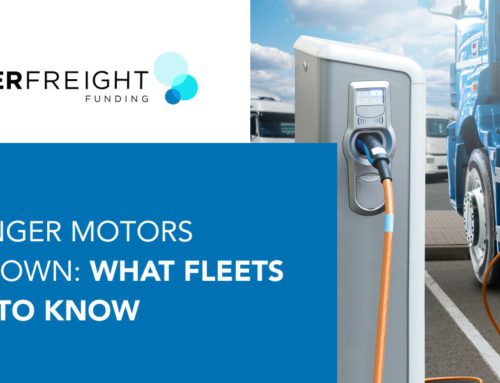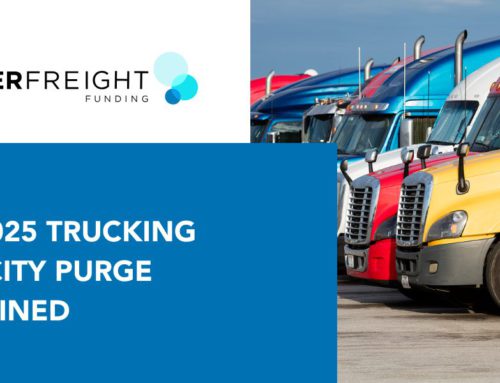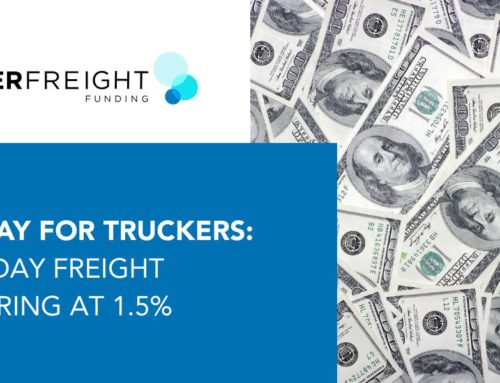As a trucker or owner-operator, you’ve likely heard of drop-and-hook shipping. You might have even heard carriers, shippers and drivers rave about how easy, convenient and efficient this method is compared to its counterpart — live-load trucking. Is drop-and-hook trucking — also known as drop-and-pick trucking — suitable for you or your circumstances?
Jump To Section
In this article, you’ll learn what makes drop-and-hook and live-load trucking different. Drop-and-hook loads have unique advantages and drawbacks compared to more traditional freight methods. The experts at Porter Freight Funding strive to help you choose the best processes for your business. We’ll explore some of the benefits and challenges of drop-and-hook trucking to help you determine whether it’s the right cargo transfer method for you.
Feeling Restricted by the Current Economy?
Porter Freight Funding provides funding solutions for owner-operators, small to mid-sized companies, and even large fleets. We provide solutions to manage the effects of an economic slowdown including freight factoring, dispatching services, fuel cards, and more.
What Does Drop-and-Hook Mean?
Drop-and-hook trucking is the process of dropping freight off and hooking up a pre-loaded shipping trailer to your truck tractor. This process occurs at the same loading facility and is often referred to as the “no-touch” freight transfer method because the truck driver does not have to load or unload their trailer. The drop-and-hook trucking method allows drivers to drip off a trailer, hook up a new one and hit the road again — often within a short period.
Overall, the drop-and-hook transfer method is efficient for carriers and shippers. The process minimizes transportation costs and saves everyone time — especially drivers. However, drop-and-hook trucking also has its setbacks. For example, the new trailer might not be in an ideal pickup location behind other containers waiting for their drivers. In that case, you might need to request help from the facility to move the surrounding trailers. Despite this, the drop-and-hook process usually doesn’t take more than an hour.
Drop-and-Hook Trucking vs. Live-Load Trucking
With a live load, a warehousing provider must unload a trailer while the driver waits on-site at the loading facility. Live loads often result in drivers spending significant amounts of time waiting around, as the process can take several hours. Scheduling errors can lengthen this time frame, adding several more hours of waiting to an already extended period off the road. Many times, drivers do not receive compensation for the time they spend waiting for the loading and unloading processes to complete.
Plus, warehousing facilities must schedule live loads within a specific window to ensure adequate docking space and labor for the loading and unloading process. Any delays can cause further downtime, preventing drivers from being as productive as possible.
The drop-and-hook freight trucking method solves this problem by eliminating the driver’s waiting period. This unique process can significantly improve efficiency and make drivers’ jobs easier.
How Does the Drop-and-Hook Trucking Process Work?
Drop-and-hook trucking is usually a fast and straightforward process, which is why many truckers prefer it over live-load trucking. At its heart, drop-and-ship trucking is an easy matter of swapping trailers.
A warehouse or distribution center usually expects a driver within a set time frame for a scheduled drop-off. Once the driver arrives, they park their truck and unhook their current trailer before swapping it for a pre-loaded trailer. With drop-and-hook trucking, all the truck driver must do is leave their trailer in the shipping yard and pick up a loaded or empty trailer before heading out again. This method is a simple, fast and convenient process for all parties.
After the truck driver leaves, a warehouse facility worker hooks up a smaller truck to the driver’s old trailer and backs it into the warehouse unloading center to unload at their convenience. Once a facility worker unloads the dropped-off trailer, they can reload it with new goods. Another trucker can pick the freight up to take it to a store or another facility.
This hands-off loading and unloading process saves truck drivers uncompensated time, effort and labor. It also means that warehouses and fulfillment centers can accept more shipments to turn a better profit.

Why Do Shippers Use Drop-and-Hook Trucking Services?
Drop-and-hook trucking has other advantages in addition to saving carriers and shippers time. Shippers opt to use the drop-and-hook shipping method for the following reasons:
- Overcoming shipping backlogs: Many warehouses and distribution centers have shipping backlogs. These sites do not have the staffing to load and unload live loads, making drop-and-hook trucking the more efficient solution.
- Hauling floor-loaded cargo: Some shippers load and stack small, maneuverable cargo onto the trailer’s floor without pallets. This method allows them to use the trailer’s space more efficiently and makes loading and unloading easier.
- Simplifying scheduling: Live loads often take several hours to complete. Drop-and-hook trucking allows distributors to accept more deliveries and unload them at their convenience.
- Using additional yard space: Some warehousing facilities have huge docking yards, making it easier to accept more trailers despite a lack of workers. They opt for the drop-and-hook shipping model to receive shipments and continue earning a profit.
- Handling high shipping volumes: Fortune 500 companies and major distribution or fulfillment centers have larger shipping volumes than mom-and-pop companies. The drop-and-hook trucking model makes it easier to accept more loads and stay on schedule.
The Key Advantages of the Drop-and-Hook Shipping Model
The drop-and-hook trucking model benefits carriers of all sizes, from Fortune 500 companies to small and medium-sized businesses. Some of the unique benefits of drop-and-hook trucking include the following:
- Fast, efficient deliveries: Loading and unloading a live load shipment is time-consuming for shippers and carriers. The warehouse must also have the space and personnel to unload the freight. Drop-and-hook trucking is a fast and efficient process for shippers and carriers alike.
- Convenient scheduling: The drop-and-hook trucking method makes scheduling drop-offs easier for carriers, drivers and shippers. Drivers can drop and hook a trailer at any time of day, and the warehouse can load and unload trailers at their convenience.
- Hands-free transfers: Some warehousing facilities require drivers to help load and unload trailers, which is time-consuming. Plus, drivers are not usually compensated for this additional time or labor by their carrier. Drop-and-hook trucking is a hands-free cargo transfer method that is easy and efficient for drivers who need to remain productive and profitable by moving on to their next high-paying job.
- Reduced shipping costs: The drop-and-pick shipping model is more efficient and cost-effective for busy, high-stake distribution or fulfillment centers. These facilities rely on efficient supply chains and can’t afford to deal with shipping delays that harm their businesses’ reputations and bottom lines.
- Mutually beneficial: Drop-and-hook trucking saves shippers and carriers time, allowing shippers to accept more deliveries and unload them at their convenience. Likewise, drivers can take on more high-paying loads to increase their productivity and revenue. This trucking method also helps drivers avoid costly detention fees resulting from lengthy loading and unloading times.
The Unique Challenges and Setbacks of Drop-and-Hook Trucking
While drop-and-hook trucking boasts many benefits, it also has some potential setbacks for drivers. If you’re considering trying out the drop-and-hook trucking method, be sure to weigh the pros and cons to determine if it’s the right method for you. Some of the unique challenges of this shipping model include:
- Unfamiliar equipment: With drop-and-hook trucking, you must trade your trailer for a new one each time. Swapping trailers means you might acquire equipment that is unfamiliar to you or be in less-than-optimal shape. Drivers must be flexible, knowing that each new trailer’s coupling process might look different.
- Hookup problems: Each trailer is different, and the coupling process might differ with each load of freight. Drivers may also experience coupling issues. For example, heavy trailers are often dropped and require a warehouse facility worker to bring a crane or forklift to lift the trailer. To ensure your safety, set your brakes before hopping out of the tractor-trailer, chock the trailer wheels and thoroughly inspect your fifth wheel and mounting before coupling.
- Inaccessible trailers: Occasionally, a trailer will be challenging to access due to being hidden behind other trailers, making the loading and unloading process more time-consuming. You might also have to request help from a facility worker to move the trailers so you can access yours. Though this process is more time-consuming than it would be if the trailer were readily accessible, it should take no more than an hour.
- Off-site trailers: While the drop-and-hook process usually takes place at one facility, there might be times when a trailer is stored off-site. In these cases, the driver will need to travel to the off-site location to pick up the new trailer. This additional travel adds time to the process. However, drop-and-hook trucking is still more efficient than unloading and reloading a trailer with each delivery.
- Overweight trailers: Drivers must comply with all interstate and intrastate travel guidelines. Therefore, drivers must ensure their trailer’s equipment and weight are compliant. If the warehousing facility overloads the trailer, the driver is responsible and must return to the facility to offload items — no matter how far they traveled.
Partner With Porter Freight Funding to Find High-Paying Drop-and-Hook Deliveries
If you need help finding and booking drop-and-hook loads, turn to Porter Freight Funding. Our freight dispatching outsourcing services save truckers time finding and building relationships with reliable drop-and-hook dispatching network companies. We’ll help you connect with a vetted network of drop-and-hook freight trucking companies across the U.S., regardless of your fleet type. Our broker database provides the essential information truckers need to find and book lucrative loads and ensure brokers can see their vehicles and availability.
Contact the Porter Freight Funding team today to learn more about our freight dispatching services. Call 205-397-0934 to speak with an Account Executive. You can also fill out our online contact form, and we’ll get in touch shortly!




